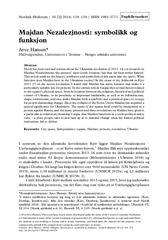Majdan Nezalezjnosti: symbolikk og funksjon
Permanent link
https://hdl.handle.net/10037/17561Date
2016Type
Journal articleTidsskriftartikkel
Peer reviewed
Author
Hansen, ArveAbstract
Much has been said and written about the Ukrainian revolution of 2013–14, yet research on Maidan Nezalezhnosti, the protests’ most iconic location, has thus far been rather limited. This article analyses the history, attributes and symbolism of this particular city space. What function does Maidan have in the Ukrainian society? In the cause of my fieldwork in Kyiv 2013–15 on the recent revolution, I found that Maidan has many features that make it a particularly suitable site for protests. In the current article I argue that several factors related to the square’s physical space, from its location between the religious, historical and political centres of Ukraine, to its proximity to important landmarks, as well as its infrastructure, shape, architecture, and size, make Maidan both a symbolic and a practical space to occupy for people demanding change. Since the collapse of the Soviet Union Maidan has acquired a special significance for Ukrainians. The name of the square itself could be interpreted as a protest against Russia, and the many protests and three revolutions on Maidan have given it a particular revolutionary meaning. I argue that Maidan functions as a socio-political safety valve – a place people turn to and turn up at to demand change when the formal political institutions fail to deliver.
Is part of
Hansen, A. (2020). Mass Protests from a Spatial Perspective: Discontent and Urban Public Space in Kyiv, Minsk, and Moscow. (Doctoral thesis). https://hdl.handle.net/10037/17417Publisher
Cappelen Damm AkademiskCitation
Hansen A. Majdan Nezalezjnosti: symbolikk og funksjon. Nordisk Østforum. 2016;30(2):118-134Metadata
Show full item recordCollections
Copyright 2016 The Author(s)


 English
English norsk
norsk